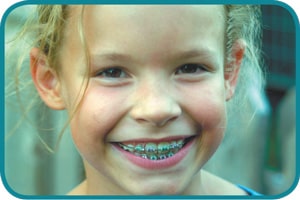Braces aren’t just for teens
by Jeffrey Eberting, D.M.D., M.S.
 You’re with your eight-year old at his or her semi-annual dental check-up, and the dentist casually comments, “You should probably make an appointment with the orthodontist for an evaluation.” You think, “What?! But my child is only eight years old! What on Earth would the orthodontist need to do to my child when there are so many baby teeth present?”
You’re with your eight-year old at his or her semi-annual dental check-up, and the dentist casually comments, “You should probably make an appointment with the orthodontist for an evaluation.” You think, “What?! But my child is only eight years old! What on Earth would the orthodontist need to do to my child when there are so many baby teeth present?”
This is a situation I am sure in which many parents have found themselves – the family dentist or pediatric dentist making a referral to an orthodontist for an evaluation when that patient (their child) still has a significant amount of primary teeth in place. Unless the dental condition is obvious, many parents are left wondering why there could be a need for orthodontic treatment at such a young age.
The American Association of Orthodontists recommends that a child have his or her first orthodontic evaluation at the age of seven years. Why this age when in many patients, the primary teeth have not even begun to exfoliate or loosen? For most seven-year olds, the permanent first molars – or the “six-year” molars – have erupted, and the occlusion – or the “bite” – is being established. The orthodontist can begin to evaluate whether the patient’s facial growth is creating a normal bite, an overbite, or an underbite. In most cases, a seven-year old will not require early orthodontic treatment. For some, however, there may be a need for interceptive or “Phase 1” treatment; maybe not at the age of seven, but perhaps a couple years later.
“The American Association of Orthodontists recommends that a child have his or her first orthodontic evaluation at the age of seven years.”
In my practice, I am very selective about which cases merit early treatment, and which can wait until all the permanent teeth have erupted. There must be a definite dental or skeletal need, in which early orthodontic treatment would benefit the patient. For me, simply, dental crowding or spacing does not mean that we need to initiate treatment. Most of my Phase 1 treatment cases have a skeletal component which requires correction – crossbites, developing underbites, or severe overbites. These types of cases make for good early treatment cases, because in a preadolescent patient, the facial bones are much more pliable and easier to manipulate.
To correct a crossbite, many orthodontists use a maxillary (upper arch) expander of some type, which pushes the two halves of the upper jaw apart. The goal is to “widen” the upper jaw. Maxillary expansion becomes more difficult when a patient has completed his or her adolescent growth, as the suture joining the two halves of the upper jaw calcifies or hardens.
If a patient has a developing underbite, I prefer to start early treatment at an even younger age (age six or seven). This is because treatment involves using what is called a “reverse-pull” or “facemask” headgear, which is worn at night, to pull the upper jaw forward. This forward movement becomes more difficult to achieve as the patient gets closer to adolescence due to the calcification of the sutures of the facial bones.
The cases that I treat to address issues which are solely dental in nature are because of an interceptive need. Upper front teeth which are protruding excessively can be at risk for trauma should they be hit during a fall or at play. These spaces can be closed and the teeth pulled inward to avoid any potential damage to them. Some patients present with such a severe level of crowding, that the ultimate treatment plan will include extracting the four first premolars. I can also plan a sequence of extractions of primary teeth and permanent teeth, called “serial extraction,” which will allow for the eruption of the remaining permanent teeth in more favorable positions, making orthodontic treatment more effective.
Finally, there are instances where I will initiate early orthodontics for patients whose dental condition are such that they are being teased or ridiculed by their peers. In many of these cases, the treatment time is short and relatively simple, but the increased patient self-confidence and improved self-image create invaluable rewards. If you have any questions about the condition of your child’s teeth or whether it is time to schedule an orthodontic evaluation, please see your family dentist or orthodontist.
Dr. Eberting owns Hardin Valley Orthodontics and holds degrees from Duke University and Temple University in both General Dentistry and Orthodontics. He is a member of the American Dental Association, the TN Dental Association, the Second District Dental Society, the American Association of Orthodontists, the Southern Association of Orthodontists, and the TN Association of Orthodontists. He is a Fellow in the Academy of General Dentistry. Dr. Eberting enjoys theater, music running, politics, reading and movies. He has three children.
Related posts
Newsletter Subscribe
Newest Posts
Set Up a Parental Control for Online Safety
Have you ever wondered how long your children spend in front of a device without your supervision? Yes, it is…
Adopt A Life, Save A Life
By Jeff Ashin, CEO, Young-Williams Animal Center. Photo by: Young-Williams Animal Center Are you or your child thinking of adding…

